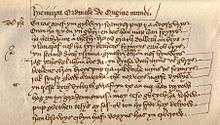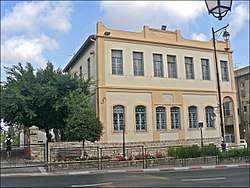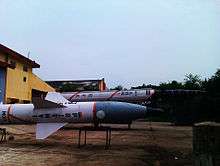List of revived languages
A revived language or "Phoenix language" and "Zombie language" is one that, having experienced near or complete extinction as either a spoken or written language, has been intentionally revived and has regained some of its former status.
The most frequent reason for extinction is the marginalisation of local languages within a wider dominant nation state, which might at times amount to outright political oppression. This process normally works alongside economic and cultural pressures for greater centralisation and assimilation. Once a language has become marginalised in this way, it is often perceived as being "useless" by its remaining speakers, who associate it with low social status and poverty, and consequently fail to pass it on to the next generation.
The only substantial success story in the field of language revival is Hebrew; all other cases are projects of limited success.
Ainu
The Ainu language of the indigenous Ainu people of northern Japan is currently moribund, identified by Japanese scholars as a "dying language" since the 1920s.[1] A 2006 survey of the Hokkaido Ainu indicated that only 4.6% of Ainu surveyed were able to converse in or "speak a little" Ainu.[1] As of 2001, Ainu was not taught in any elementary or secondary schools in Japan, but was offered at numerous language centres and universities in Hokkaido, as well as at Tokyo's Chiba University.[2] An Ainu language radio station was established in Hokkaido in 2001, and manga books have been produced in the language.[3]
The work of researcher Kayano Shigeru has been prominent in the revival of Ainu, including the recording of the Ainu oral epics known as yukar. Shigeru also began the Nibutani Ainu Language School in 1983, the first Ainu school in Japan.[4]
Andalusian Arabic
Mahomat Abrahim (born Eduardo) Bosch Ramon, an amateur researcher and student of history, Islamic civilization, and geopolitics, has been learning Andalusian Arabic, specifically the variant spoken by Valencian Moriscos before the Expulsion of 1609, as a second language and is also trying to encourage other Spanish Muslim converts to learn it.[5]
Barngarla
Barngarla (Parnkalla, Banggarla) is an Australian Aboriginal language of the Barngarla people in Eyre Peninsula, South Australia, Australia. It is currently being revived by Ghil'ad Zuckermann (University of Adelaide) and the Barngarla community, based on 170-year-old documents.[6]
Chochenyo
The Muwekma Ohlone Tribe of California has revitalized the Chochenyo language, which was last spoken in the 1930s.[7][8][9] As of 2009, many students were able to carry on conversations in Chochenyo.[10]
Cornish

Cornish was once spoken in the Duchy of Cornwall until it became extinct as a spoken language in the late 18th century. The language had been in decline since the 14th century and by the time of the death of the last fluent speakers, was only spoken in the western fringes of the county. Dolly Pentreath (d. 1777) is believed to have been the last speaker of the language. Literature from the Medieval and Tudor periods, and fragments, including grammars, from the 17th, 18th and 19th centuries survived, which allowed Cornish to be reconstructed by a small group of Celtic enthusiasts in the 20th century as part of the Celtic Revival. These Cornish language revivalists borrowed heavily from Welsh and Breton in order to aid in the creation of the modern Cornish language. The reconstruction of the language was known for disputes over orthography during the late 20th century, until a Standard Written Form was agreed upon in 2008. The number of Cornish speakers is difficult to estimate, but it is believed that some 500 individuals have a degree of fluency in the language. The language is now taught in some schools in Cornwall. UNESCO recently reclassified the language from "extinct" to "critically endangered".[11]
Dalmatian
The Dalmatian language was spoken in Dalmatia, a coastal region of Croatia, in the Middle Ages. Its last known native speaker was Antonio Tuone Udaina, who died on June 10, 1898, as the result of an explosion. The Dalmatian language is being revived by pro-autonomist Dalmatian activists, and today is estimated that there are about 20 fluent Dalmatian speakers and more than one hundred people with some knowledge of the language.[12]
Diyari
Diyari is an Australian Aboriginal language spoken in the far north of South Australia, to the east of Kati Thanda (Lake Eyre). Studies and translations by German Lutheran missionaries in the late 19th and early 20th centuries created an extensive written form. By the early 21st century, only a few fluent speakers of Diyari remained. However, by 2013 Peter K. Austin had produced a dictionary and grammar of the language, and as of 2019, there is a project under way to teach it in schools.
Hawaiian
On six of the seven inhabited islands of Hawaii, Hawaiian was displaced by English and is no longer used as the daily language of communication. The one exception is Niʻihau, where Hawaiian has never been displaced, has never been endangered, and is still used almost exclusively. Native speakers of Niʻihau Hawaiian speak among themselves in a way significantly different from the Hawaiian of the other islands—so different that it can be difficult for non-Niʻihau speakers of Hawaiian to understand. The most marked difference between Niiahauan and Hawaiian is that the Hawaiian K sound is often replaced with a T sound in Niihauan.
Efforts to revive the language have increased in recent decades. Hawaiian language immersion schools are now open to children whose families want to retain (or introduce) Hawaiian language into the next generation. The local NPR station features a short segment titled "Hawaiian word of the day". Additionally, the Sunday editions of the Honolulu Star-Bulletin feature a brief article called Kauakukalahale, written entirely in Hawaiian by a student.
Hebrew

Hebrew was revived as a spoken language two millennia after it ceased to be spoken (although it was always used as a written language), and is considered a language revival "success story". Although used in liturgy, and to a limited extent commerce, it was extinct as a language used in everyday life until its revival, considered impractically archaic or too sacred for day-to-day communication, although it was, in fact, used as an international language between Jews who had no other common tongue, with several Hebrew-medium newspapers in circulation around Europe at the beginning of the 19th century, and a number of Zionist conferences being conducted exclusively in Hebrew. Starting in the late 19th century, it was revived as an everyday spoken language as part of the emerging Zionist movement. Eliezer Ben-Yehuda largely spearheaded the revival efforts, and his son Itamar Ben-Avi was raised as the first native Hebrew speaker since Hebrew's extinction as an everyday language. Hebrew is now the primary official language of Israel, and the most commonly spoken language there. It is spoken by over 9,000,000 people today.[13] Most of them live in Israel or are Israeli expatriates, but many in Jewish communities outside Israel have undertaken its study.
Kaurna
Kaurna is an Australian Aboriginal language of the Kaurna people in Adelaide, South Australia, Australia. It is currently being revived by the Kaurna Warra Pintyandi, a committee of Kaurna Elders and youth, teachers, linguists and other researchers based at the University of Adelaide.
Latin

Latin was historically the language of the Roman Empire, but spread through Europe and beyond, thanks partially to its role in the Roman Catholic Church and in higher register.
Feature films and broadcasting have been conducted in Latin. Two notable examples include 1976's Sebastiane by Derek Jarman and Paul Humfress, and Mel Gibson's The Passion of the Christ (which also contains long sections in Aramaic). Harry Potter has even been translated into Latin and ancient Greek.[14]
Lazuri (Laz)
The UNESCO Atlas of the World's Languages in Danger (2010) declares Lazuri as a language that is definitively endangered. Lazuri is a Southwest Caucasian language spoken by ca. 30,000 people as their mother tongue along the East Black Sea coast of Turkey and in some parts of the Autonomous Republic of Adjara (Salminen, 2007). The region where the Lazi people live is called Lazona (Benninghaus, 1989). Because Lazuri is primarily an oral language, and all new speakers tend to grow up bilingual (typically speaking Lazuri and Turkish), the language is at risk of extinction (e.g., Yuksel-Sokmen & Chasin, 2008). Although the Lazuri alphabet was first established around the late 20s by a native folklorist, named Iskender Tsitasi, who published periodicals and poems until 1938, there were many obstacles to learn and to teach Lazuri due to the lack of language learning resources and limited documentation of the language (interview with language activist İsmail Avcı Bucaklişi in Istanbul, April 2012). Hence, Lazuri remained a primary spoken language until Lazoglu and Feuerstein re-introduced the Lazuri Alboni or Alphabet in Latin letters in 1984 and started to publish periodicals, called 'Ogni' ("Did you hear"). The first Lazuri Dictionary (Bucaklişi & Uzunhasanoğlu, 2006) was among the first one to adopt the Lazuri Alboni. The Little Prince by Antoine de Saint-Exupery become the first book which has been formally translated into the Lazuri Alboni by Sinan Albayrakoğlu (2011) who worked four years on the Turkish to Lazuri translation. Also, in 2011 the Bosphorus University of Istanbul started to offer Lazuri as an elective class for beginners. With the recent establishment of the Lazika Yayin Kolektif (Lazika Publication Collective) in 2010, current and future generations of students, teachers, authors, and scholars of Lazuri are encouraged to contribute to the process of language revitalization, thus paving the way for a Lazuri literature.
Livonian
Livonian is a Finnic language spoken in Latvia. It is one of the three languages (along with Manx and Cornish) listed as revived by the UNESCO Atlas of the World's Languages in Danger.[15]
Leonese
Leonese was recognised as a seriously endangered language by UNESCO, in 2006. The only legal reference to this language is in the Autonomy Statute of Castile and León. The Province of León government supports the knowledge of this language through courses, by celebrating "Leonese Language Day" and by sponsoring literary efforts in the Leonese language, such as "Cuentos del Sil", where nine writers from teenagers to people in their eighties develop several stories in Leonese. The Leonese Local Government uses the Leonese language in some of their bureaus, organizes courses for adults and in 2007 organized Leonese Language Day. The Leonese Local Government official website uses the Leonese language. The Leonese language is taught in two schools of León city since February 2008. The local authority for education said it would be taught in all Leonese schools next course.
Manx
Manx is a language spoken in the Isle of Man, which is in the Irish Sea, between Scotland, England, Ireland and Wales. Manx ceased to function as a community language during the first quarter of the 20th century, but was revived by enthusiasts at a time when there were still a number of native speakers alive. Although at one point no native speakers of the language were alive and it may have been officially classified as "dead" in 1975, the revival appears to have gained strength in recent years. There is a regular programme in Manx on Manx Radio. As of 2012 there were sixty-nine pupils undergoing their education through the medium of Manx at the Bunscoill Ghaelgagh.
Māori
Māori is the indigenous language of New Zealand, where it was commonly spoken until the 20th century.[16] In recent times initiatives have been taken to revitalize Māori as a spoken language.
Mutsun
Mutsun is one of the eight Ohlone languages originally spoken in the San Juan Bautista, California area. The last fluent speaker, Ascencion Solórzano de Cervantes, died 1930.[17] The contemporary tribe, Amah Mutsun Tribal Band, is working to revive the language using the notes of linguist John Peabody Harrington. The Mutsun language has a program to teach it to tribal members and a dictionary is being planned. The initial member to galvanize the language revitalization is Quirina Geary.[18] Immersion into the language is planned in books, songs, and games[19] Rumsen and Chochenyo are the other two Costanoan languages being revived along with Mutsun.
Occitan Gascon

The Aranese language, a standardized form of the Pyrenean Gascon variety of the Occitan language spoken in the Aran Valley, in northwestern Catalonia is still spoken. Once considered to be an endangered language, spoken mainly by older people, it is now experiencing a renaissance; it enjoys co-official status with Catalan and Castilian (Spanish) in Catalonia,[20] and since 1984 has been taught in schools.[21]
Old Prussian
Old Prussian is a revitalized language, originally went extinct by the early 18th century, an attempted revival of Old Prussian has been made on the uncertain time, first revitalization on 1989 as Revived Old Prussian or "Neo"-Prussian.
Palawa kani
Palawa kani is an attempt to revive various Tasmanian dialects in a single combined form.
The original Tasmanian languages, which may have numbered a dozen or more, became extinct in 1905 when the last native speaker died. As part of community efforts to retrieve as much of the original Tasmanian culture as possible, efforts are made to (re)construct a language for the indigenous community. Due to the scarcity of records, Palawa kani is being constructed as a composite of the estimated 6 to 12 original languages.
Theresa Sainty and Jenny Longey were the first two "language workers" to work on the project in 1999.
Sanskrit
Sanskrit was a pan-Indian language in Vedic times but lost its prominent place among spoken dialects in modern India. A number of attempts to revive Sanskrit have been made from the 18th century onward. However, it has been challenged in this role by various community languages, Hindi, Urdu and English.
Many of India's and Nepal's scientific and administrative terms are named in Sanskrit, as a counterpart of the western practice of naming scientific developments in Latin or Classical Greek. The Indian guided missile program that was commenced in 1983 by DRDO has named the five missiles (ballistic and others) that it has developed as Prithvi, Agni, Akash, Nag and Trishul. India's first modern fighter aircraft is named HAL Tejas.
Modern Sanskrit is spoken in around four villages in India. The Mattur village in central Karnataka, Shimoga district claims to have native speakers of Sanskrit among its population. Historically the village was given by King Krishnadevaraya of the Vijayanagara Empire to Vedic scholars and their families. People in his kingdom spoke Kannada and Telugu.[22]
Samskrita Bharati (Sanskrit: संस्कृतभारती, IPA: [sɐ̃skɽɪtɐ bʱaːɽɐtiː]) is a non-profit organization working to revive Sanskrit, also termed Sanskrit revival. The organization has its headquarters in New Delhi, and U.S. chapter headquarters in San Jose, California. The Samskrita Bharati office in Bangalore is called "Aksharam" and houses a research wing, library, publication division, and audio-visual language lab for teaching spoken Sanskrit.
Wampanoag
In the 21st century, Wampanoag became the first Native American language in the United States to be revived, with young children brought up in the language.[23]
References
- Cultural Diversity, Heritage and Human Rights: Intersections in Theory and ... - William Logan, Máiréad Nic Craith - Google Books
- Can Threatened Languages Be Saved?: Reversing Language Shift, Revisited : A ... - Joshua A. Fishman - Google Books
- Hokkaido: A History of Ethnic Transition and Development on Japan's Northern ... - Ann B. Irish - Google Books
- Multicultural Japan: Palaeolithic to Postmodern - Donald Denoon, Mark Hudson - Google Books
- 18 November, 2019 |título= A DICTIONARY OF ANDALUSI ARABIC Retrieved on 18 November, 2019
- "News.com.au | News Online from Australia and the World". Thepunch.com.au. 2016-09-26. Retrieved 2017-01-11.
- Ron Russell (2007-03-28). "The Little Tribe That Could. As descendants of San Francisco's aboriginal people, the Muwekma Ohlone Indian tribe seldom gets much respect. But that could be about to change". SF Weekly. Archived from the original on 2012-08-27. Retrieved 2012-07-24.
- Kathleen Maclay (2004-06-04). "06.04.2004 - Conferences focus on saving native languages". UC Berkeley News. Retrieved 2012-07-23.
- "California magazine". Archived from the original on 4 April 2008. Retrieved 14 January 2015.
- "Ethnologue report for language code: cst". Retrieved 2012-07-24.
- "BBC News - Cornish language no longer extinct, says UN". BBC News. Retrieved 14 January 2015.
- "A million and a half Israelis struggle with Hebrew". Israelhayom.com. Archived from the original on 2013-11-04. Retrieved 2017-01-11.
- Wilson, Andrew (2006). "Harry Potter in Greek". Andrew Wilson. Retrieved 28 July 2008.
- UNESCO Atlas of the World's Languages in Danger
- "History of the Māori language - Māori Language Week | NZHistory, New Zealand history online". Nzhistory.net.nz. 1987-08-01. Retrieved 2017-01-11.
- Okrand, Marc. "Mutsun Grammar" (PDF).
- "Mutsun Language Revitalization" (PDF). u.arizona.edu. Archived from the original (PDF) on 2016-03-09. Retrieved 2016-01-19.
- Shulman, Robert. "Reading Dr. Seuss in Mutsun". articles.latimes.com.
- Ediciones El País. "Cataluña incorpora el aranés como su tercera lengua oficial". EL PAÍS. Retrieved 14 January 2015.
- "Inici. Llengua catalana". 0.gencat.cat. Retrieved 2017-01-11.
- This village speaks gods language 13 Aug 2005 Times of India Retrieved on September 14, 2008
- 'We Still Live Here' Traces Comeback of Wampanoag Indian Language. PBS Newshour, 11-10-2011.
